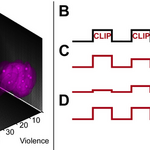Neuroscience

Psychologists at Harvard University using neuroimaging say they have resolved the century-old debate over the existence of Extra-Sensory Perception(ESP) - and it doesn't exist.
The research was led by Samuel Moulton, a graduate student in the department of psychology in the Faculty of Arts and Sciences at Harvard University with Stephen Kosslyn, John Lindsley Professor of Psychology at Harvard and was published in the Jan. 2008 issue of the Journal of Cognitive Neuroscience. The scientists used brain scanning to test whether individuals have knowledge that cannot be explained through normal…

Phantom noises, that mimic ringing in the ears associated with tinnitus, can be experienced by people with normal hearing in quiet situations, according to new research published in the January 2008 edition of Otolaryngology – Head and Neck Surgery.
The Brazilian study, which consisted of 66 people with normal hearing and no tinnitus, found that among subjects placed in a quiet environment where they were asked to focus on their hearing senses, 68 percent experienced phantom ringing noises similar to that of tinnitus. This is compared to only 45.5 percent of participants who heard phantom…

Laser surgery to correct vision problems has been in use since the early 1990s. Photorefractive Keratotomy (PRK) is typically used to correct low to moderate myopia, while laser in-situ keratomileusis (LASIK) is preferred for high myopia corrections. Although over 18 million LASIK procedures have been performed worldwide, there is still some controversy regarding the maximum correction possible and efficacy with this technique.
In an article published in the January 2008 issue of the American Journal of Ophthalmology, researchers from Miguel Hernandez University, Medical School, Alicante,…

A new study of combat-exposed Vietnam War veterans shows that those with injuries to certain parts of the brain were less likely to develop post-traumatic stress disorder (PTSD). The findings, from the National Institutes of Health (NIH) and the National Naval Medical Center, suggest that drugs or pacemaker-like devices aimed at dampening activity in these brain regions might be effective treatments for PTSD.
PTSD involves the persistent reliving of a traumatic experience through nightmares and flashbacks that may seem real. Twenty percent to 30 percent of Vietnam vets (more than 1 million)…

At its core, healthy neurological function hinges on the efficient passage of information between brain cells via the synapse.
Figuring out how the synapse traffics this information -- a process called neurotransmission -- is crucial to understanding the function of the healthy and diseased brain.
Now, a team led by researchers at Weill Cornell Medical College in New York City has spotted a crucial new piece to that puzzle.
Their findings, published today in Neuron, focus on the role of a cellular enzyme called Synaptojanin 1 (Synj1).
Prior research had suggested the enzyme was key to…

Twelve healthy subjects in their 60s and 70s showed a different pattern of brain activations during thirst and satiation than did 10 healthy subjects in their 20s who drank the same amounts and underwent imaging with positron-emission tomography (PET). Dysfunction in activated neural regions could help explain why older adults show the dangerous tendency toward reduced drinking in response to dehydration.
San Antonio and Australian researchers reported the PET study of thirst in this week’s Proceedings of the National Academy of Sciences Online Early Edition.
The team has conducted a series…

A new study of twins indicates that the genetic foundation for the brain’s ability to recognize faces and places is much stronger than for other objects, such as words. The results, which appear in the December 19 issue of the Journal of Neuroscience, are some of the first evidence demonstrating the role of genetics in assigning these functions to specific regions of the brain.
“We are social animals who have specialized circuitry for faces and places,” says Arthur W. Toga, PhD, director of the Laboratory of NeuroImaging at UCLA School of Medicine. “Some people are better at recognizing faces…

Violence is a frequent occurrence in television shows and movies, but can watching it make you behave differently?
Although research has shown some correlation between exposure to media violence and real-life violent behavior, there has been little direct neuroscientific support for this theory until now.
Researchers at Columbia University Medical Center’s Functional Magnetic Resonance Imaging (fMRI) Research Center have shown that watching violent programs can cause parts of your brain that suppress aggressive behaviors to become less active.
(A) Each of the eighty-four clips was rated…

Young chimpanzees have an “extraordinary” ability to remember numerals that is superior to that of human adults, according to a report in the December 4th issue of Current Biology.
“There are still many people, including many biologists, who believe that humans are superior to chimpanzees in all cognitive functions,” said Tetsuro Matsuzawa of Kyoto University. “No one can imagine that chimpanzees—young chimpanzees at the age of five—have a better performance in a memory task than humans. Here we show for the first time that young chimpanzees have an extraordinary working memory capability for…

Individual brain chemistry and genes could be key to understanding why some people become addicted to nicotine and why the chemical compound's effects appear to diminish at night, University of Colorado at Boulder researchers say.
"The depth of a person's addiction to nicotine appears to depend on his or her unique internal chemistry and genetic make-up," said lead author Jerry Stitzel, an assistant professor in CU-Boulder's department of integrative physiology and researcher with CU-Boulder's Institute for Behavioral Genetics.
He and his team set out to evaluate the effects of nicotine over…